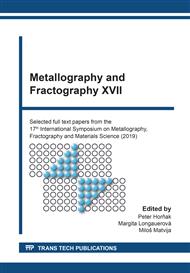p.33
p.43
p.48
p.54
p.60
p.66
p.75
p.80
p.86
SEM Imaging of In Situ Tensile Testing of 27CrNiMoV Steel
Abstract:
In-situ tensile testing of a 27CrNiMoV alloy which is used for steam turbine rotors was carried out using scanning electron microscope (SEM). Deformation and crack formation and propagation were examined with this test. Small (45 × 10 × 1.5 mm, with gauge length of 20 mm), flat samples based on dog-bone shape were prepared from the steel. The material in its initial state contained high number of defects in form of microcracks. A comparison of behaviour at tensile tests of samples without visible defect and with crack in the gauge section was performed. Apparently, the presence of defect in the initial state showed direct influence on properties like lower tensile strength. The sample, its necking and propagated crack is displayed at different stages of the tensile load. In-situ testing reveals differences in the sample deformation. The defect-free sample is affected in its whole body and regular necking can be observed, whereas the presence of the crack in the defect samples concentrates stress to a smaller area and also changed the shape of the stress-strain curve.
Info:
Periodical:
Pages:
60-65
Citation:
Online since:
November 2020
Authors:
Keywords:
Price:
Сopyright:
© 2020 Trans Tech Publications Ltd. All Rights Reserved
Share:
Citation:


